Abstract
To detect the degradation of clean water, it is necessary to characterize its quality through water quality indices using seasonal water sampling and analysis. In the present study, the initialization of the monitoring by surface and dam water sampling was conducted in multiple areas of Greece, including the Eastern Thermaikos Gulf, Mouriki, and Marathonas basins, during both the dry and wet periods of 2022. The dam reservoirs were also monitored by capturing their orthomosaic mapping. The classification of the samples according to the Canadian Council of Ministers of Environment Water Quality Index (CCME WQI) showed that all dam water samples examined and Mouriki area samples have excellent water quality in terms of physical and chemical characteristics. However, some samples from the Eastern Thermaikos Gulf and Marathonas basins suffer from seawater intrusion, which is indicated by the high concentration levels of Na+ and Cl−, and anthropogenic activities shown by the elevated concentrations of NO3−. Moreover, the high concentration of As in samples from the Eastern Thermaikos Gulf is attributed to geothermal fluids. The importance of Cl−, NO3−, and As presence in water quality at the studied areas is also verified by the sensitivity analysis performed, pointing out the requirement of sustainable management.
1. Introduction
The significance of water is well known since it is a natural resource necessary for the growth of all living organisms, but it is also a part of the majority of the daily processes conducted, i.e., industrial, irrigation, waste treatment, etc. Anthropogenic activities due to the direct discharge on surface water have set it as the most polluted waterway [1,2]. Unfortunately, apart from the anthropogenic part of water degradation and depletion lately, climate change also negatively affects water quality, enhancing water scarcity due to the impact it has on the hydrological cycle [3,4]. Groundwater depletion is a significant threat in arid and semi-arid areas. Climate change projections provide extreme variations in rainfall accumulation, with more intense storms and flood events and longer-duration droughts. Nowadays, the hydrological cycle has been altered, especially due to greenhouse gases, resulting in a shortened snowmelting season, a fact that causes the insufficient recharge of groundwater. However, irrigation is the secondary reason for the diminished recharge [5]. Agricultural activities are constantly increasing due to population growth contributing to groundwater deterioration and depletion by inducing pollutants and demanding excess irrigation, respectively [6].
Sustainable development depends on various factors, such as research, innovation, conservation of natural resources, general environmental protection, the development of green technologies, and technical methods [7]. Sustainable groundwater management (SGWM) is a part of environmentally sustainable development. SGWM has the ability to ensure climate-resilient supplies of water that are required to achieve goals for food security, energy generation, and access to drinking water [8]. It is challenging to maintain a high quality of surface water and groundwater since they are the main sources of drinking water. This quality maintenance is a great factor of concern, with the predictions showing that in 2025, approximately two-thirds of the population will experience water stress. To achieve that, monitoring and assessment are crucial for an early diagnosis that allows the proper remediation treatment at an early stage of pollution or depletion [2,5]. Kalaitzidou et al., 2020 reported the increasing presence of toxic substances, either organic or inorganic, in water that may result in waterborne diseases, a fact that is also depicted in the evolution of drinking water legislation with the incorporation of new classes of pollutants, i.e., polyfluoroalkyl substances (PFAS) [9]. Thus, even though the surveillance of any interaction that occurs on surface water and groundwater is a costly procedure, it constitutes an essential tool for assessing the quantitative and qualitative regime of water quality. The threats and pollution pathways have to be identified so suitable water quality management can be applied [10]. For this assessment, the water quality index (WQI) is the tool that is suitable for the determination of the quality regime of water bodies and also points out, by sensitivity analysis, the most important pollutant [11,12,13,14].
Water quality indices were developed following ongoing research on water quality. The evolution of this useful tool is based on the four requirements of their calculation, which include (i) the selection of the evaluated parameters; (ii) the estimation of the sub-index values for the comparison of the parameters on a single scale in order to result in a non-dimensional value; (iii) the effect on the water quality of each parameter has to be weighted; and (iv) finally the incorporation of the calculations, thus the estimation of the WQI score [4,11]. The variety of WQIs is wide, with the Canadian Council of Ministers of Environment Water Quality Index (CCME WQI) standing out since it is flexible in the parameters’ selection, simple, i.e., it skips the subindex estimation, sensitive to parameter changes, does not overestimate water quality, and has global acceptance also [15,16,17,18].
Due to the global recognition of CCME WQI, researchers have applied the index to study sites in Greece. More specifically, Gikas et al., 2020 evaluated the water quality along the river Nestos basin, with the river sites examined showing poor to marginal water quality and the reservoirs presenting a better classification of moderate to fair for most of the samples [19]. The Rhodes area was examined by Alexakis et al., 2022 who reported that most of the samples evaluated showed excellent water quality, though they pointed out the need for continuous monitoring due to seawater intrusion in the area [20]. Furthermore, Panagopoulos et al., 2022 examined the water quality on 111 rivers in Greece with measurements from a time period of 2018–2020, resulting in fair marginal or poor water quality for the majority of the samples [14]. Finally, Gikas et al., 2023 reported poor water quality for the Laspias river, fair water quality for the Kosythos river, and marginal water quality for the Lissos river, according to the CCME classification [16]. All the above-mentioned research highlights the need for monitoring, the flexibility of CCME score calculation, the potential for global use of the index as a helpful tool for monitoring water quality, and the stricter classification that derives from the calculation of the score compared to other indices.
The current research approach is implemented to provide key data for sustainable development following the orientation of the United Nations. Target 6.6 is about the protection and restoration of water-related ecosystems and encounters mountains, forests, wetlands, rivers, aquifers, and lakes. To accomplish this target in the study areas, the existing dams were evaluated as cost-effective groundwater augmentation techniques suitable for various hydrogeological settings. The aim of this study is to initiate the monitoring and characterization of the water bodies examined in the coastal aquifer in the Eastern Thermaikos Gulf and Marathonas basins and the inland basin of Mouriki and indicate the importance of prevention and protection from groundwater depletion. Seasonal samples were obtained, and their physical and chemical characteristics were evaluated in order to determine the differences between the wet and dry periods of 2022. All the samples were evaluated according to the EU Directive for drinking water for their physical chemical characteristics, while 13 parameters, i.e., pH, conductivity, Cl−, SO42−, NO3−, NO2−, PO43−, NH4+, Sb, As, Cd, Pb, and Hg, were applied for the calculation of the CCME WQI score and the further characterization of the samples [9]. Monitoring by CCME WQI in all samples and the capture of framed orthophotographs in the dam areas are crucial for sustainable water management.
2. Materials and Methods
2.1. Study Areas
This study areas are in the Mediterranean region and include the coastal aquifer in the Eastern Thermaikos Gulf and Marathonas basins and the inland basin of Mouriki, as shown in Figure 1. Both the Mouriki basin and the Eastern Thermaikos Gulf basins are located in Northern Greece, while the Marathonas basin is in Central Greece. These three areas were chosen due to their different hydrogeological regimes, morphological conditions, and land uses. The hydrogeological regime and land use in the Eastern Thermaikos Gulf and Mouriki basin have been analyzed in the previous work of Ntona et al., 2023 [10].
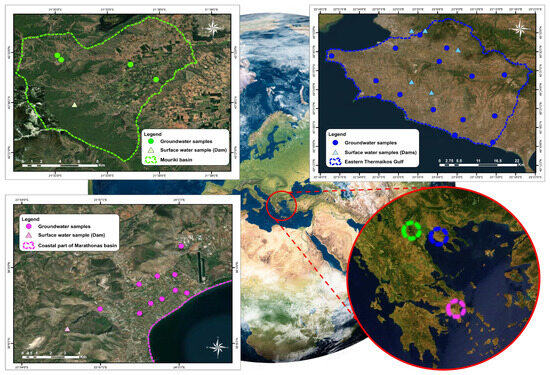
Figure 1.
Locations in Greece of the studied areas.
2.1.1. Eastern Thermaikos Gulf
The Eastern Thermaikos Gulf basin is located in the eastern part of the Thermaikos Gulf in northern Greece. Industrial, irrigation, and drinking water requirements are covered by the public water supply system and numerous wells owned by the locals. Seasonal variations are observed in the physical and chemical properties of the water due to the greater demand during the touristic summer season and the increased agricultural activities during the same period [8,21]. During the last decades, the area has been monitored in terms of nitrate pollution [8], boron concentrations due to the geothermal water in the basin [22], and stable isotopes, tritium, and isotopic ratios such as 234U/238U [23], pointing out some of the seasonal pollution in the basin.
2.1.2. Mouriki Basin
Mouriki Basin is located north of Kozani city in Northern Greece, where agricultural and livestock activities mainly take place. The high demand for irrigation water alongside the drinking water necessities causes high stress in the area, and the scientific community is focused on studying the recharge of the basin [10,24]. Data on the seasonal variations of the physical chemical composition of the area are very limited.
2.1.3. Marathonas Basin
The Marathonas basin is located in the eastern part of Attica, in southern Greece. A porous aquifer is located in the coastal area of the site, whereas karstic aquifers are found in areas underlain by marbles [25]. The main part of the region is covered by urban areas, forests (pine, mixed forest, sclerophyllous vegetation), shrubs, oak, pasture, cultivated fields, and wetlands, with spatial and temporal variations in their extent during the last few years [26], while a devastating fire destroyed a notable part of the vegetation in 2009. Groundwater is subjected to intense pumping due to extensive agricultural activities, with an extended irrigation period (greenhouses) in most of the plain. For this reason, flooding problems occur, and climate change has shown that flooding phenomena are multiplying. Since 2004, the Rapentosa dam has been constructed in the Marathonas Plein in order to avoid these flooding phenomena [27].
2.2. Hydrochemical Analysis
2.2.1. Sample Collection
The water samples were collected from boreholes and dams during the wet and dry periods of the hydrological year 2022 in all the areas (Figure 1). In the Eastern Thermaikos Gulf, five surface water samples were collected from the dams. In the Mouriki and Marathonas basins, two more water samples were collected from the dams in each area. The boreholes were selected based on the hydrogeological regime and land use of the areas. Then, twenty-nine groundwater samples were collected and analyzed. Ten groundwater samples were collected in the Marathonas basin (G1–G10), fifteen groundwater sample points in the Eastern Thermaikos Gulf (G11–G25), and four in the Mouriki basin (G26–G29).
For the needs of the current research, automated flights were executed using a DJI Phantom Pro V2 UAS and the Pix4Dcapture software (Version 4.11.0) to capture georeferenced, framed orthophotographs. The flights were performed during the periods of June (Mouriki dam-D_6 and Marathonas dam-D_7) and July 2021 (dams of Vasilika-D_3, K. Scholari-D_4, Lakomma-D_5, Thermi-D_1, and Triadi-D_2).
2.2.2. Chemical Analysis
The parameters determined were pH, conductivity, Cl−, SO42−, NO3−, NO2−, PO43−, NH4+, Sb, As, Cd, Pb, Ca2+, Na+, K+, Mg2+, and HCO3− in the filtrates of each sample using a Perkin Elmer AAnalyst 800 Atomic Absorption Spectrophotometer applying either flame or graphite furnace. For the Hg concentration, a Bacharach cold vapor mercury analyzer system (Coleman Model 50B) was used. The Cl−, SO42−, and NO3− concentrations were determined using an Alltech 600 Ion Chromatography system with a Transgenomic ICSep AN1 column, using as eluent a 1.7 mM NaHCO3/1.8 mM Na2CO3 solution, supplied by Merck, >99.7% and 99.5 % purity respectively. The pH and electric conductivity were determined using the WTW 3310 instrument. The diphenylcarbazide method [3500-Cr D] was applied for Cr(VI) concentration determination using a Perkin Elmer Lambda 2 UV/VIS spectrophotometer version 3.7, equipped with 10 cm length-path measurement cells, and the reported results are the mean value of 3 replicates.
2.3. Canadian Council of Ministers of Environment Water Quality Index (CCME WQI)
From a hydrological point of view, Greece has a Mediterranean climate type, which is divided into two time periods (i.e., dry and wet) during a year. More specifically, the wet period’s duration begins in October and lasts until March; thus, the dry period is from April to September [1]. For the CCME WQI index, two sampling periods are required, so as already mentioned, the sampling was conducted during the dry and wet periods of 2022.
The CCME WQI was selected for the water quality of the water bodies in the studied areas as a well-established method acceptable to the scientific community. It was initially suggested by Canadian jurisdictions and a committee under the Canadian Council of Ministers of the Environment (CCME) that provided the WQI, which is dimensionless and allows the evaluation of different kinds of water bodies. The flexibility that this index provides lies in the selection of the inputs used to be applied in the calculation of the index score, with the sampling protocol requiring at least eight parameters and not more than twenty [28]. The calculation of index scores is carried out using the methodology presented in Figure 2.
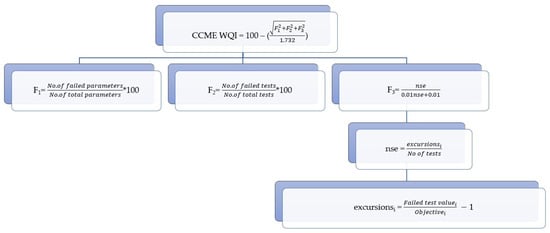
Figure 2.
CCME calculation. Where: F1 (Scope) computes the percentage of the non-qualified parameters according to the regulations/guidelines. F2 (Frequency) depends on the test repetitions, and according to that, F2 calculates the percentage that indicates the individual test failures. F3 (Amplitude) is the quantity of failed tests that show non-qualified parameters. nse (normalized sum of excursions).
Classification of the water body is conducted by comparing the score to the five categories suggested by CCME in Table 1. Finally, for a better evaluation of the CCME WQI scores, a sensitivity analysis is conducted.

Table 1.
Water quality classification according to CCME WQI.
3. Results
3.1. Study Area Georeferenced
Figure 3 shows the orthomosaic images captured for each flight area, while in Figure S1 Supplementary Material there is the image still from the Pix4D orthophoto processing program for Mouriki dam. Orthomosaic mapping is used for the environmental monitoring of the sites. More specifically, the technical characteristics of the dams are shown in Table 2.
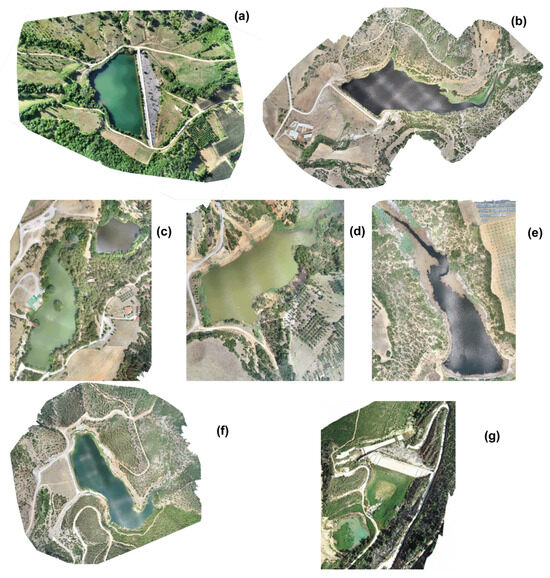
Figure 3.
Orthomosaic of the (a) Mouriki, (b) Vasilika, (c) Thermi, (d) Kato Scholari, (e) Lakoma, (f) Triadi, and (g) Rapentosa dam. The above results are one of the deliverables (point cloud, mesh, orthomosaic, DEM) of the photogrammetric process exported from proper software.

Table 2.
Technical characteristics of the dams.
3.2. Basic Chemical Analysis
Groundwater is one of the most important natural resources for water supply, while at the same time, many aquifers are under stress due to overexploitation, especially in the Mediterranean region, where limited surface water resources cannot meet water demands [29]. The piper diagram produced by the determined parameters of the groundwater (GW) samples is presented in Figure 4, showing the variation of the chemical composition during September 2021 and June 2022. The quality of GW samples from the Eastern Thermaikos Gulf (ETG) and Mouriki basin has been analyzed in the previous work of Ntona et al. 2023 [30]. In the GW samples from the coastal part of the Marathonas basin, the order of the cation concentrations is Ca2+ > Na+K+> Mg2+ and Cl− > HCO3− for the anions, similar to the results reported by Papazotos et al., 2019 [31].
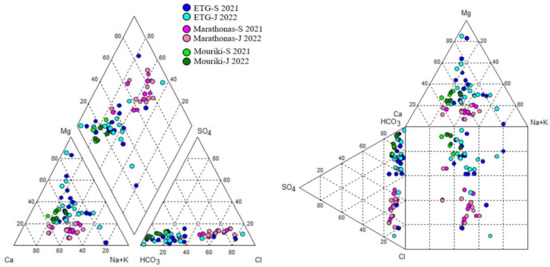
Figure 4.
Groundwater samples are projected in the Piper (left) and Durov (right) diagrams.
Dams as percolation tanks have been applied worldwide to infiltrate intermittent stream flow and recharge alluvial aquifers. Despite that, the water stored in these facilities is subjected to evaporation and contamination. For this purpose, the seasonal variation of dams’ water quality is evaluated. No significant variations are noted in dam water (DW) samples from all the areas (Figure 5). The cation concentrations of DW samples are in the order Ca2+ > Mg2+ > Na+K+ and those of the anions are in the order HCO3− > Cl−.
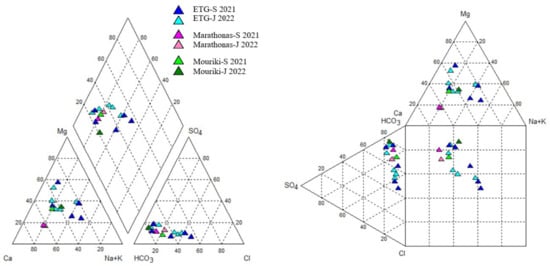
Figure 5.
Dam water samples are projected in the Piper (left) and Durov (right) diagrams.
As already mentioned for the CCME WQI score, the parameters selected were evaluated according to the EU Directive for drinking water (Table S1, Supplementary Material). The determination method used and the detection limit of each parameter are also presented in Table S1, Supplementary Material. All the determined parameters are shown in Tables S2–S4 in the Supplementary Material, and all the parameters that are detected over the respective regulation limit are marked in red. More specifically, the main pollutants of contamination affecting the water quality in the groundwater and dam reservoirs of the study sites in Greece examined during this study are Na+, Cl−, NO3−, and As. Figure 6 shows the parameters mostly affected by the seasonal variations, i.e., electric conductivity (E.C. at 25 °C), chloride (Cl−) and nitrates (NO3−) for the Marathonas basin. Unfortunately, 50% of groundwater samples have E.C. values greater than the regulation limit (2500 μS/cm), with higher values presented during the wet period. Results for chlorides show a similar trend for the samples G_1–G_6 and G_8–G_9 that are over the regulation limit for the E.C., with chloride values much higher than the regulation limit (250 mg/L). The combination of high E.C. and Cl− values is indicative of seawater intrusion, which is a serious degradation factor for coastal aquifer systems [32]. According to the seasonal variations, Cl− presents higher concentrations during the dry period for most of the samples. However, samples G_1 and G_4 show a higher Cl− concentration during the dry period. Alongside, nitrate pollution that exceeds the regulation limit of 50 mg/L is indicative of the agricultural activity effect in the area. Aquifer degradation due to nitrates was previously reported by Psychoyiou et al., 2007 and Papazotos et al., 2019 [31,33]. Like Cl− concentration monitoring, the seasonal variations for NO3− also show higher concentrations during the dry period for most of the samples, but for G_1, G_2, and G_3, they show higher NO3− concentrations during the dry period.
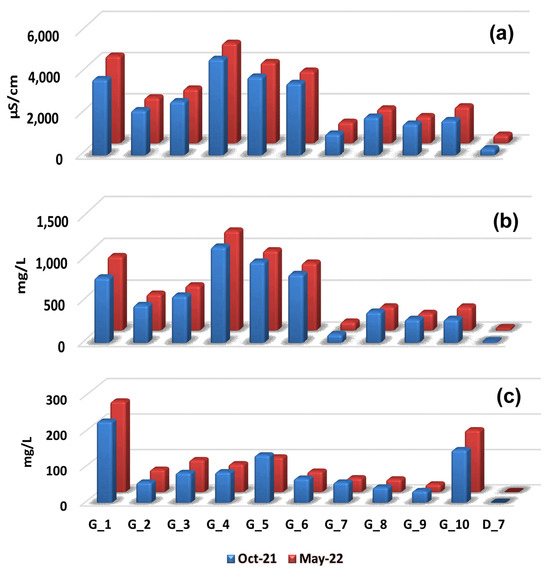
Figure 6.
Seasonal variation of (a) E.C. (25 °C), (b) Cl−, and (c) NO3− of Marathonas basin samples.
Data on the parameters mostly affected by the Eastern Thermaikos Gulf basin are presented in Figure 7, where it is obvious that sample G_25 is not suitable for drinking water purposes, a fact attributed to seawater intrusion. Similar to the results in the Marathonas basin, higher values of E.C. are presented during the dry period in the Eastern Thermaikos Gulf basin as well. It should also be underlined at this point that samples G_18 and G_21 show very high concentrations of As due to the alteration of rocks by hydrothermal fluids, as already reported by Kazakis et al., 2017 [7]. Seasonal variation in As concentration shows that during the dry period, its presence is higher in the aquifer. As verified by Kazakis et al., 2020 nitrate pollution is a serious threat in the area since agricultural activities are very intensive and fertilizers are extensively applied. The results of nitrate in samples G_12, G_19, G_20, and G_25 are verified [8]. Results are very different between dry and wet periods since NO3− shows a higher concentration during the wet period for G_19 and G_20 and during the dry period for G_12 and G_25, attributed to the mobility of nitrates on the different soil types, also indicating the multiple factors affecting the water quality of the area.
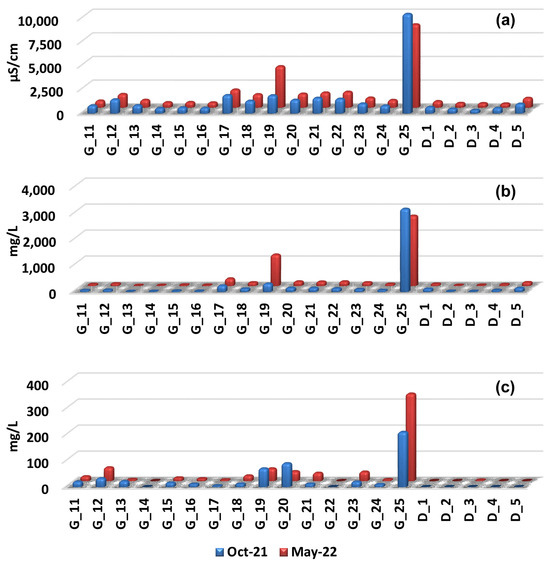
Figure 7.
Seasonal variation of (a) E.C. (25 °C), (b) Cl−, and (c) NO3− of Eastern Thermaikos Gulf basin samples.
Figure 8 shows the results of E.C. at 25 °C, Cl−, and nitrates NO3− for the Mouriki basin, which show insignificant variations between the wet and dry periods while all the parameters determined are within the regulation limits. Moreover, all the measured parameters are within the regulation limits for drinking water, and no major pollutants are determined through the physical chemical evaluation of the samples of the area.
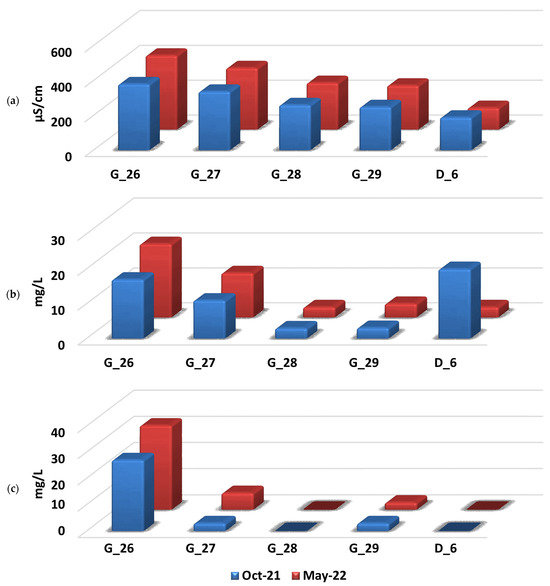
Figure 8.
Seasonal variation of (a) E.C. (25 °C), (b) Cl−, and (c) NO3− of Mouriki basin samples.
3.3. CCME Classification
The seasonal data were used for the CCME score calculation as well (Table S5, Supplementary Material). The classification of the water samples (groundwater and dams) is presented locally in Figure 9, Figure 10 and Figure 11 for Marathonas, Eastern Thermaikos Gulf, and Mouriki basin, respectively. Figure 8 shows that due to the fact that the aquifer is negatively affected both by agricultural activities and seawater intrusion, fair quality is the classification for samples G_1, G_4, G_5, G_6, and G_8. This classification suggests the treatment of water prior to human consumption.
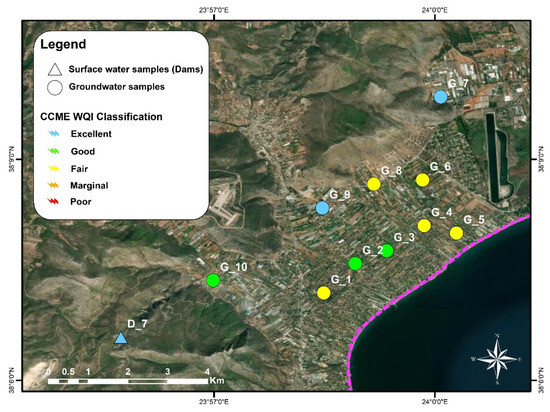
Figure 9.
CCME water quality classification of samples in the coastal part of the Marathonas basin.
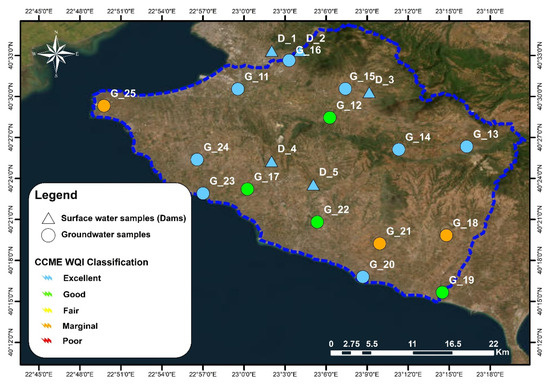
Figure 10.
CCME water quality classification of samples in the Eastern Thermaikos Gulf.
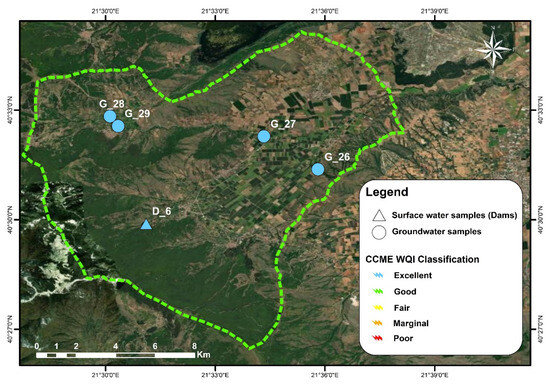
Figure 11.
CCME water quality classification of samples in the Mouriki basin.
The Eastern Thermaikos Gulf basin CCME WQI classification of the samples is presented in Figure 10, where seawater intrusion results in lower scores for samples G_25 and G_19, and the geothermic fluid in the area degrades samples G_18, G_21, and G_22. The agricultural activities are the reason for the degradation of the G_12 sample. The variety of the Eastern Thermaikos Gulf basin in classification is indicative of the need for constant monitoring due to the very different sources of pollution in the area.
It is clear from Figure 11 that the Mouriki basin evaluation shows excellent water quality regarding the physicochemical characteristics of the samples and can be used for the drinking water supply of the area. It is noticeable at this point that the Mouriki basin has a better groundwater quality, probably due to the geographical location of the basin, which is far from the sea, indicating that seawater intrusion has a significant impact on the degradation of the coastal aquifer in the Marathonas and Eastern Thermaikos Gulf basins. Moreover, all dam water samples show excellent water quality according to CCME WQI, indicating a buffer capacity for seasonal variations and agricultural activities, while since their location is not close to the coastal aquifer, none of the dams show signs of seawater intrusion.
3.4. Sensitivity Analysis
Sensitivity analysis was conducted to point out which variables most strongly influence the water quality in the studied areas. Sensitivity analysis indicates how the uncertainty of the final response is affected by the parameters used for the index calculation. Figure 11 presents the sensitivity analysis of variables in calculating CCME for the 13 parameters, i.e., pH, conductivity, Cl−, SO42−, NO3−, NO2−, PO43−, NH4+, Sb, As, Cd, Pb, and Hg examined for the score’s calculation. The sensitivity analysis was conducted by withdrawing the variables one by one from the calculation of the CCME score. The initial CCME WQI and the recalculated scores without each parameter are shown in Figure 12.
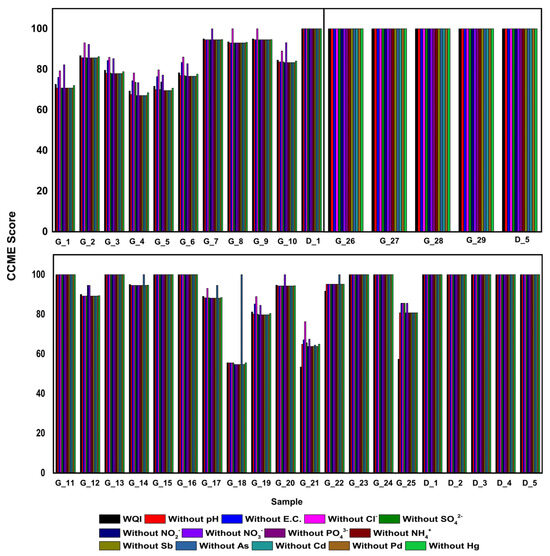
Figure 12.
Sensitivity analysis of CCME WQI after the removal of the parameter concentrations encountered in index score calculation for each sample.
Removing the parameters has resulted in scores different than the initial ones, as presented in Table S6 in Supplementary Material, where the altered classification is highlighted. As expected, the samples that showed excellent water quality according to the CCME score were not affected by the parameters encountered for the score calculation, still presenting excellent classification after the removal of any parameter. However, the samples that are affected by seawater intrusion, hydrothermal fluids, or agricultural and anthropogenic activities show variations that are mostly attributed to the removal of Cl−, NO2−, NO3−, and As. Marathonas basin water quality is mainly affected by Cl− and NO3− being the parameters that mostly affect the water quality in the area, with Cl− being the most important one (Table S7, Supplementary Material). In Eastern Thermaikos, Gulf Cl−, NO3, and As are the most important parameters that affect the CCME score, thus water quality. The samples that contain As are affected by its presence, presenting different classifications after the removal of this parameter from the score calculation. The most important parameter for the area is how to classify the water samples. It should be mentioned at this point that As is not contained in all samples, and for the rest of the samples, Cl− is the most important parameter for the water quality.
4. Discussion
Aiming to achieve SGWM, this research monitors groundwater quality and initiates data collection on the seasonal variations that are caused by climatic or anthropogenic activities in the studied areas. It should be noted that the application of managed aquifer recharge (MAR) methods is considered necessary in areas of the Mediterranean region, such as the areas examined during this study, where the natural recharge of the aquifer is not achievable or the infiltration recovery has a low rate and is incomplete [34]. MAR projects involve integrated management for the protection or recovery of surface and groundwater sources [35,36,37] and include the artificial recharge (AR) method, which constitutes a crucial solution for mitigating water scarcity in arid and semi-arid regions under the effects of climate change [38]. In detail, aquifer storage and recovery (ASR) systems are economical and sustainable technologies providing natural water treatment [39]. ASR uses seasonally available surface water to improve aquifer recharging. Several pilot schemes and demonstrative artificial recharge schemes have been implemented. For instance, groundwater recharge dams have been applied for a variety of reasons, such as the reduction of groundwater depletion [40,41] and the mitigation of seawater intrusion [42]. Bearing in mind the seasonal demands in the touristic areas of the Eastern Thermaikos Gulf and Marathonas basin, along with the different demands on irrigation water at all studied areas during a year, the ASR requirement is easily aroused.
Researchers in arid and semi-arid regions evaluate the performance of small dam construction in cases where brief periods of intense precipitation cause catastrophic floods [43,44], like the scope of Rapentosa dam construction. After all, the multipurpose uses of a reservoir or dam were long ago known. Albergel, 2012 mentions that a small dam could be exploited for irrigation, cattle transhumance, flooding control, and recharge, while Pimenta et al., 2012 also mention that small reservoirs can be constructed for small hydropower units with no alteration of the water quality of the reservoir [45,46]. Results have revealed the positive impact of these ASR systems on water resources that can also be applied to the dams examined during this study. According to Djuma et al. 2017, small dams can provide reliable groundwater recharge even in cases of ephemeral streams. Based on our knowledge, the investigation of the use of dams for energy production and groundwater recharge is limited [47]. Nevertheless, recent research by Trček and Mesarec 2023 investigates the effect of the hydropower dam on the recharge processes of the aquifer depending on the application of hydrogen and oxygen isotopes (18O, 2H, and 3H). The results showed an increase of more than 50% in the groundwater depth in the observation wells. Under this aspect, variations in groundwater level are of utmost importance for the evaluation of the surface water-groundwater interaction [10,48].
One of the main concerns in the implementation of AR projects is the identification of suitable sites, where the selection of the optimum ASR method depends on the hydrogeological characteristics and the need for fresh water in the area. For a successful ASR method, tools such as modeling that technology offers can significantly aid this purpose. Towards that direction, the research team has already applied modeling strategies such as SWAT (Soil and Water Assessment Tool) and DPSIR (Driving Force-Pressure-State-Impact-Response), where they reported that the Eastern Thermaikos Gulf may face drought problems due to climate change and that there will be alterations attributed to runoff, and the predicted evapotranspiration is at high levels that exceed 63.7% [10,30]. The next step of this research was to examine, through modeling, the potential of MAR in the reservoirs and dams located in Greece. Karakasanis et al., 2023 reported that 253 of those are potentially good candidates, and a simultaneous good water quality (calculated by a water quality index that was conducted during the current study) would allow the multipurpose usage of the reservoir or the dam [49]. So, the current research’s overall goal is to investigate the use of existing small dams as subsurface reservoirs for hydropower production, aquifer recharge, and irrigation needs.
Pollution of groundwater due to overextraction, mineral leaching of metal pollutants, excess fertilizer use that penetrates the aquifer, geothermal conditions, and anthropogenic activities is more likely to occur. Furthermore, rivers are exposed over large areas, and pollution may be caused by industrial waste disposal or any other anthropogenic source of pollution [7,50,51]. The results of the present study showed that small dam water quality is excellent and seasonal variations have limited impact on the physic-chemical variations. Dam water is also less affected by agricultural and anthropogenic activities; they are mostly constructed far from industrial areas, thus showing more stable parameters that can produce better water quality for potable use [52].
A potential threat in surface waters that are treated and intended for drinking water purposes, as Katsiapi et al., 2007 and Lymperopoulou et al., 2011 reported, might be an algae bloom, i.e., phytoplankton and cyanobacterial, respectively, caused by seasonal variations such as temperature change, which might make the water unsuitable for drinking purposes [53,54]. In general, algae blooms are a major concern for surface water, especially due to the rapid global warming that affects their cultivation. Attention has to be given to the natural organic matter of the potential drinking water surface sources since high-temperature treatments that include high oxidation agents result in the production of trihalomethanes (THMs) that cause adverse effects on human health [55]. Data from this study showed that all dams present good physical and chemical characteristics and can be treated successfully for drinking water production in terms of microbial charge.
To improve the current results that set the basis for the monitoring of the sampling sites, a combination of groundwater level measurements and climate scenarios is suggested. In the next research steps, methods of determining the efficacy of the dams in this study areas will be implemented based on simulation modeling methods. The current research was conducted in the context of a research project on (i) the production of hydroelectric power from small dams as a renewable energy source and (ii) groundwater recharge in Greece. The results of the first qualitative evaluation approach showed a high quality of DW, according to the CCME WQI. The data derived from this study should be strengthened with data from the next seasonal sampling periods for a better classification, and alongside groundwater level monitoring, the interaction of the aquifer with dams should also be specified. Additionally, the microbiological parameters should also be encountered in the next sampling periods alongside measurements such as dissolved oxygen, total suspended solids, and biological oxygen demand. A better understanding of the dam environment should include both superficial and benthic sampling. This methodology is suggested to be applied to more sampling sites throughout Greece, and a monitoring network is to be set up. That way, groundwater evaluation in terms of drinking water and agricultural usage is better assessed. Moreover, the monitoring can provide crucial information on the multipurpose usage of the dam water that may allow its usage as potable or irrigation water and the possibility of hydropower production.
WQI is a significant tool for the determination of water quality before the application of MAR techniques [56,57]. Following the guide about the optimization of dam operations by Karakatsanis et al. (2023), the current work provides reliable results regarding water quality classification for the improvement, protection, and sustainable use of surface and groundwater [49]. An application of MAR techniques to the selected dams in Greece will be applied in future research steps. Moreover, future research steps should also include an artificial intelligence algorithm implemented for forecasting WQI in the study areas since artificial intelligence and soft computing techniques have proved to be efficient and precise tools in determining and managing groundwater quality [58,59]. Due to the potential uncertainty of groundwater recharge, which is one of the main threats to water resources [60], and the fact that groundwater storage is affected by the climate crisis and the growing water demand [61], the prediction of the groundwater level is essential for the accurate management of groundwater resources [62]. For this purpose, machine learning methods, fuzzy-based systems [63], and remote sensing data [64] have been implemented worldwide for the prediction of groundwater level fluctuations that must be applied to the study areas of the present study as well.
5. Conclusions
Factors such as climate change, population growth, and industrialization affect water quality, resulting in the continuous demand for stricter regulations on water pollutant limits. In this study, all samples (36 in total) were analyzed, and their physicochemical characteristics were determined and evaluated to determine whether they could be drinking water sources. These results were also used to evaluate the quality of the surface and dam reservoir waters by implementing the CCME WQI. Calculations were carried out considering 13 parameters (i.e., pH, conductivity, Cl−, SO42−, NO3−, NO2−, PO43−, NH4+, Sb, As, Cd, Pb, and Hg), and CCME WQI indicated that there are plenty of water sources with excellent quality. The rather strict WQI CCME used to classify the samples of groundwater and dam water in three different areas in Greece, i.e., Marathonas, the Eastern Thermaikos Gulf, and the Mouriki basin, showed similarities for the coastal aquifers in Marathonas and the Eastern Thermaikos Gulf basin.
The main results for groundwater samples are summarized as follows:
- Marathonas basin (2 Excellent, 3 Good, and 5 Fair water samples) pollution factors:
- ➢
- seawater intrusion
- ➢
- agricultural activities
- Eastern Thermaikos Gulf basin (8 Excellent, 4 Good, and 3 Marginal water samples) pollution factors:
- ➢
- seawater intrusion
- ➢
- agricultural activities
- ➢
- geothermic fluid by rock alteration
- Mouriki basin (4 Excellent water samples):
- ➢
- Samples of physical and chemical characteristics within drinking water regulation limits
- Mouriki basin seems be less affected with excellent water quality according to CCME WQI.
Samples from the Mouriki basin present almost stable physical and chemical characteristics throughout the year. However, differences between the dry and wet periods of 2022 are shown for both the Marathonas and Eastern Thermaikos Gulf basins. Not all samples show the same trend, but most of them are degraded during the dry period. To better evaluate the source of the pollution, more samples should be examined in the future.
Fortunate is the fact that all the dams examined during this study also show excellent water quality. CCME scores a fact that shows the buffering capacity of the dams during the seasonal variations, with insignificant seasonal variations during the wet and dry periods. However, it is of great importance to continue the monitoring for any seasonal periodical variations, determining more parameters that will also result in a more accurate classification of the samples while at the same time the degradation of the aquifer is better evaluated. Sensitivity analysis identified Cl− as the major parameter that affects water quality in the Marathonas basin and Eastern Thermaikos Gulf, but for the samples containing As, this was the most important parameter influencing the water quality. In order to prevent future pollution, fertilizer use should be reduced, while at samples suffering from seawater intrusion, appropriate management that prevents overexploitation and overpumping due to agricultural activity is necessary to control salinity. Artificial recharge can also contribute to the fight against salinization and water degradation.
For proper water management, not only the physical chemical characteristics that result in the WQI index should be monitored, but the orthomosaic images are also of high importance in environmental monitoring. Further monitoring of this study sites of the dams through orthomosaic monitoring can provide information on the potential for water depletion at the respected locations that will allow the proper sustainable management of the aquifer recharge and pollution prevention. The final evaluation of these dam samples will be done in terms of a multipurpose usage i.e., drinking water, irrigation water, recharge, and hydropower production. The importance of the produced data lay in the possibility of the initialization of small dam multipurpose usage by specifying the optimal algorithm for energy production and groundwater enrichment. Setting the basis for this multipurpose usage is a matter of potential global small-dam exploitation.
Supplementary Materials
The following supporting information can be downloaded: https://www.mdpi.com/article/10.3390/w15234170/s1, Figure S1: Image still from the Pix4D orthophoto processing program at Mouriki Dam; Table S1: Parameters examined for the CCME implementation method for determination and detection limit; Table S2: Results of physical chemical analysis for Marathonas Basin; Table S3: Results of physical chemical analysis for Anthemountas Basin; Table S4: Results of physical chemical analysis for Mouriki Basin; Table S5: CCME score for all water samples; Table S6: CCME score changes by the removal of variables; Table S7: CCME sensitivity index.
Author Contributions
Conceptualization, N.K.; methodology, K.K., M.M. and N.K.; software, T.P.; validation, M.M., A.Z., C.V. and A.K.; formal analysis, K.K. and M.M.N.; investigation, S.T., E.Z., M.M.N. and K.K.; resources, N.K.; data curation, T.P., M.M.N. and K.K.; writing—original draft preparation, M.M.N. and K.K.; writing—review and editing, N.K.; visualization, N.K.; supervision, A.K., M.M., A.Z., C.V. and N.K.; project administration, N.K.; funding acquisition, N.K. All authors have read and agreed to the published version of the manuscript.
Funding
This research was funded by the Hellenic Foundation for Research and Innovation (H.F.R.I.) under the “Second Call for H.F.R.I. Research Projects to Support Post-Doctoral Researchers” (Project Number: 00138, Title: Groundwater Depletion). Are Eco-Friendly Energy Recharge Dams a Solution?
Data Availability Statement
Data from the present research are available upon reasonable request.
Conflicts of Interest
Author Kyriaki Kalaitzidou was employed by the company Thessaloniki Water Supply & Sewerage Co. S.A. The remaining authors declare that the research was conducted in the absence of any commercial or financial relationships that could be construed as a potential conflict of interest.
References
- Senthil Kumar, P.; Yaashikaa, P.R. 1—Introduction—Water. In Water in Textiles and Fashion: Consumption, Footprint, and Life Cycle Assessment; Elsevier: Amsterdam, The Netherlands, 2019; pp. 1–20. [Google Scholar] [CrossRef]
- Singh, R.; Majumder, C.B.; Vidyarthi, A.K. Assessing the impacts of industrial wastewater on the inland surface water quality: An application of analytic hierarchy process (AHP) model-based water quality index and GIS techniques. Phys. Chem. Earth Parts A/B/C 2023, 129, 103314. [Google Scholar] [CrossRef]
- Koutroulis, A.G.; Papadimitriou, L.V.; Grillakis, M.G.; Tsanis, I.K.; Warren, R.; Betts, R.A. Global water availability under high-end climate change: A vulnerability based assessment. Glob. Planet. Chang. 2019, 175, 52–63. [Google Scholar] [CrossRef]
- Lukhabi, D.K.; Mensah, P.K.; Asare, N.K.; Pulumuka-Kamanga, T.; Ouma, K.O. Adapted Water Quality Indices: Limitations and Potential for Water Quality Monitoring in Africa. Water 2023, 15, 1736. [Google Scholar] [CrossRef]
- Caretta, M.A.; Mukherji, A.; Arfanuzzaman, M.; Betts, R.A.; Gelfan, A.; Hirabayashi, Y.; Lissner, T.K.; Liu, J.; Lopez Gunn, E.; Morgan, R.; et al. Water. In Climate Change 2022: Impacts, Adaptation and Vulnerability. Contribution of Working Group II to the Sixth Assessment Report of the Intergovernmental Panel on Climate Change; Pörtner, H.-O., Roberts, D.C., Tignor, M., Poloczanska, E.S., Mintenbeck, K., Alegría, A., Craig, M., Langsdorf, S., Löschke, S., Möller, V., et al., Eds.; Cambridge University Press: Cambridge, UK; New York, NY, USA, 2022; pp. 551–712. [Google Scholar] [CrossRef]
- Singh, S.; Gururani, D.M.; Kumar, A.; Kumar, Y.; Bohra, M.S.; Mehta, P. Declining Groundwater Level and Its Impact on Irrigation and Agro-production. In Advancement of GI-Science and Sustainable Agriculture; Das, J., Halder, S., Eds.; GIScience and Geo-environmental Modelling; Springer: Cham, Switzerland, 2023; pp. 217–224. [Google Scholar] [CrossRef]
- Kazakis, N.; Kantiranis, N.; Kaprara, M.; Mitrakas, M.; Vargemezis, G.; Voudouris, K.; Chatzipetros, A.; Kalaitzidou, K.; Filippidis, A. Potential toxic elements (ptes) in ground and spring waters, soils and sediments: An interdisciplinary study in Eastern Thermaikos Gulf basin, N. Greece. Bull. Geol. Soc. Greece 2017, 50, 2171–2181. [Google Scholar] [CrossRef][Green Version]
- Kazakis, N.; Matiatos, I.; Ntona, M.M.; Bannenberg, M.; Kalaitzidou, K.; Kaprara, E.; Mitrakas, M.; Ioannidou, A.; Vargemezis, G.; Voudouris, K. Origin, implications and management strategies for nitrate pollution in surface and ground waters of Eastern Thermaikos Gulf basin based on a δ15N-NO3− and δ18O-NO3− isotope approach. Sci. Total Environ. 2020, 724, 138211. [Google Scholar] [CrossRef]
- EU parliament Directive (EU) 2020/2184 of the European Parliament and of the Council of 16 December 2020 on the quality of water intended for human consumption. Off. J. Eur. Union 2020, 2019, 1–62.
- Ntona, M.M.; Busico, G.; Mastrocicco, M.; Kazakis, N. Modeling groundwater and surface water interaction: An overview of current status and future challenges. Sci. Total Environ. 2022, 846, 157355. [Google Scholar] [CrossRef]
- Chidiac, S.; El Najjar, P.; Ouaini, N.; El Rayess, Y.; El Azzi, D. A comprehensive review of water quality indices (WQIs): History, models, attempts and perspectives. Rev. Environ. Sci. Biotechnol. 2023, 22, 349–395. [Google Scholar] [CrossRef]
- Namugize, J.N.; Jewitt, G.P.W. Sensitivity analysis for water quality monitoring frequency in the application of a water quality index for the uMngeni River and its tributaries, KwaZulu-Natal, South Africa. Water SA 2018, 44, 516–527. [Google Scholar] [CrossRef]
- Hurley, T.; Sadiq, R.; Mazumder, A. Adaptation and evaluation of the Canadian Council of Ministers of the Environment Water Quality Index (CCME WQI) for use as an effective tool to characterize drinking source water quality. Water Res. 2012, 46, 3544–3552. [Google Scholar] [CrossRef] [PubMed]
- Panagopoulos, Y.; Alexakis, D.E.; Skoulikidis, N.T.; Laschou, S.; Papadopoulos, A.; Dimitriou, E. Implementing the CCME Water Quality Index for the Evaluation of the Physicochemical Quality of Greek Rivers. Water 2022, 14, 2738. [Google Scholar] [CrossRef]
- Benkov, I.; Varbanov, M.; Venelinov, T.; Tsakovski, S. Principal Component Analysis and the Water Quality Index—A Powerful Tool for Surface Water Quality Assessment: A Case Study on Struma River Catchment, Bulgaria. Water 2023, 15, 1961. [Google Scholar] [CrossRef]
- Gikas, G.D.; Lergios, D.; Tsihrintzis, V.A. Comparative Assessment of the Application of Four Water Quality Indices (WQIs) in Three Ephemeral Rivers in Greece. Water 2023, 15, 1443. [Google Scholar] [CrossRef]
- Patel, P.S.; Pandya, D.M.; Shah, M. A systematic and comparative study of Water Quality Index (WQI) for groundwater quality analysis and assessment. Environ. Sci. Pollut. Res. 2023, 30, 54303–54323. [Google Scholar] [CrossRef]
- Sutadian, A.D.; Muttil, N.; Yilmaz, A.; Perera, C. Development of River Water Quality Indices—A Review. Environ. Monit. Assess. 2016, 188, 58. [Google Scholar] [CrossRef]
- Gikas, G.D.; Sylaios, G.K.; Tsihrintzis, V.A.; Konstantinou, I.K.; Albanis, T.; Boskidis, I. Comparative evaluation of river chemical status based on WFD methodology and CCME water quality index. Sci. Total Environ. 2020, 745, 140849. [Google Scholar] [CrossRef]
- Alexakis, D.E. Applying Factor Analysis and the CCME Water Quality Index for Assessing Groundwater Quality of an Aegean Island (Rhodes, Greece). Geosciences 2022, 12, 384. [Google Scholar] [CrossRef]
- Mellios, N.; Koopman, J.F.L.; Laspidou, C. Virtual Crop Water Export Analysis: The Case of Greece at River Basin District Level. Geosciences 2018, 8, 161. [Google Scholar] [CrossRef]
- Kalaitzidou, K.; Tzika, A.M.; Simeonidis, K.; Mitrakas, M. Evaluation of boron uptake by anion exchange resins in tap and geothermal water matrix. Mater. Today Proc. 2018, 14, 27599–27606. [Google Scholar] [CrossRef]
- Kazakis, N.; Krajcar, B.I.; Barešić, J.; Philippou, K.; Pashalidis, I.; Kalaitzidou, K.; Mitrakas, M.; Ioannidou, A. Seaonal variations of tritium, uranium and stable isotopes in groundwater and spring waters in the Eastern Thermaikos Gulf basin, Northern Greece. In Proceedings of the International Symposium on Isotope Hydrology, Vienna, Austria, 20–24 May 2019. [Google Scholar]
- Patrikaki, O.; Kazakis, N.; Kougias, I.; Patsialis, T.; Theodossiou, N.; Voudouris, K. Assessing Flood Hazard at River Basin Scale with an Index-Based Approach: The Case of Mouriki, Greece. Geosciences 2018, 8, 50. [Google Scholar] [CrossRef]
- Zavridou, E.; Markantonis, K.; Argyrokastritis, I.; Voudouris, K.; Kallioras, A. Preliminary Results from Unsaturated Zone Studies in Unconfined Unconsolidated Coastal Aquifers. Proceedings 2018, 2, 642. [Google Scholar] [CrossRef]
- Gaitanis, A.; Kalogeropoulos, K.; Detsis, V.; Chalkias, C. Monitoring 60 Years of Land Cover Change in the Marathon Area, Greece. Land 2015, 4, 337–354. [Google Scholar] [CrossRef]
- Diakakis, N. Flood reconstruction using botanical evidence in Rapentosa catchment, in Marathon, Greece. Bull. Geol. Soc. Greece 2013, 47, 1388–1396. [Google Scholar] [CrossRef]
- Canadian Council of Ministers of the Environment (CCME). Canadian Council of Ministers of the Environment (CCME). Canadian Water Quality Guidelines for the Protection of Aquatic Life: CCME Water Quality Index, User’s Manual—2017 Update. In Canadian Environmental Quality Guidelines, 1999; Canadian Council of Ministers of the Environment: Winnipeg, MB, Canada, 2017; Available online: https://ccme.ca/en/res/wqimanualen.pdf (accessed on 30 September 2023).
- Gleeson, T.; Wada, Y.; Bierkens, M.F.P.; van Beek, L.P.H. Water balance of global aquifers revealed by groundwater footprint. Nature 2012, 488, 197–200. [Google Scholar] [CrossRef]
- Ntona, M.M.; Chalikakis, K.; Busico, G.; Mastrocicco, M.; Kalaitzidou, K.; Kazakis, N. Application of Judgmental Sampling Approach for the Monitoring of Groundwater Quality and Quantity Evolution in Mediterranean Catchments. Water 2023, 15, 4018. [Google Scholar] [CrossRef]
- Papazotos, P.; Koumantakis, I.; Vasileiou, E. Hydrogeochemical assessment and suitability of groundwater in a typical Mediterranean coastal area: A case study of the Marathon basin, NE Attica, Greece. HydroResearch 2019, 2, 45–59. [Google Scholar] [CrossRef]
- Mozzi, G.; Pavelic, P.; Alam, M.F.; Stefan, C.; Villholth, K.G. Hydrologic Assessment of Check Dam Performances in Semi-Arid Areas: A Case Study from Gujarat, India. Front. Water 2021, 3, 628955. [Google Scholar] [CrossRef]
- Psychoyou, M.; Mimides, T.; Rizos, S.; Sgoubopoulou, A. Groundwater hydrochemistry at Balkan coastal plains—The case of Marathon of Attica, Greece. Desalination 2007, 213, 230–237. [Google Scholar] [CrossRef]
- Derlukiewicz, N.; Mempel-Śnieżyk, A. European cities in the face of sustainable development. Ekon. Prawo. 2018, 17, 125. [Google Scholar] [CrossRef]
- Henao Casas, J.D.; Fernández Escalante, E.; Ayuga, F. Alleviating drought and water scarcity in the Mediterranean region through managed aquifer recharge. Hydrogeol. J. 2022, 30, 1685–1699. [Google Scholar] [CrossRef]
- Dillon, P.; Stuyfzand, P.; Grischek, T.; Lluria, M.; Pyne, R.D.; Jain, R.C.; Bear, J.; Schwarz, J.; Wang, W.; Fernandez, E. Sixty years of global progress in managed aquifer recharge. J. Hydrol. 2018, 27, 1–30. [Google Scholar] [CrossRef]
- Standen, K.; Costa, L.R.D.; Monteiro, J.-P. In-Channel Managed Aquifer Recharge: A Review of Current Development Worldwide and Future Potential in Europe. Water 2020, 12, 3099. [Google Scholar] [CrossRef]
- Fernández-Escalante, A.E.; San Sebastian Sauto, J.; Calero Gil, R. Sites and indicators of MAR as a successful tool to mitigate climate change effects in Spain. Water 2019, 11, 1943. [Google Scholar] [CrossRef]
- Dillon, P.; Pavelic, P.; Page, D.; Beringen, H.; Ward, J. Managed Aquifer Recharge. An Introduction; Waterlines Report Series no. 13; National Water Commisssion: Kingston, Jamaica, 2009. [Google Scholar]
- Niazi, A.; Prasher, S.; Adamowski, J.; Gleeson, T. A System Dynamics Model to Conserve Arid Region Water Resources through Aquifer Storage and Recovery in Conjunction with a Dam. Water 2014, 6, 2300–2321. [Google Scholar] [CrossRef]
- Parimalarenganayaki, S.; Elango, L. Assessment of effect of recharge from a check dam as a method of Managed Aquifer Recharge by hydrogeological investigations. Environ. Earth Sci. 2015, 73, 5349–5361. [Google Scholar] [CrossRef]
- Abdalla, O.A.E.; Al-Rawahi, A.S. Groundwater recharge dams in arid areas as tools for aquifer replenishment and mitigating seawater intrusion: Example of AlKhod, Oman. Environ. Earth Sci. 2013, 69, 1951–1962. [Google Scholar] [CrossRef]
- Dahan, O.; Shani, Y.; Enzel, Y.; Yechieli, Y.; Yakirevich, A. Direct measurements of floodwater infiltration into shallow alluvial aquifers. J. Hydrol. 2007, 344, 157–170. [Google Scholar] [CrossRef]
- Martín-Rosales, W.; Gisbert, J.; Pulido-Bosch, A.; Vallejos, A.; Fernández-Cortés, A. Estimating groundwater recharge induced by engineering systems in a semiarid area (southeastern Spain). Environ. Geol. 2006, 52, 985–995. [Google Scholar] [CrossRef]
- Albergel, J. Reservoirs, Multipurpose Use of Small Reservoirs. In Encyclopedia of Lakes and Reservoirs; Encyclopedia of Earth Sciences Series; Bengtsson, L., Herschy, R.W., Fairbridge, R.W., Eds.; Springer: Dordrecht, The Netherlands, 2012. [Google Scholar] [CrossRef]
- Pimenta, A.M.; Albertoni, E.F.; Palma-Silva, C. Characterization of water quality in a small hydropower plant reservoir in southern Brazil. Lakes Reserv. Sci. Policy Manag. Sustain. Use 2012, 17, 243–251. [Google Scholar] [CrossRef]
- Djuma, H.; Bruggeman, A.; Camera, C.; Eliades, M.; Kostarelos, K. The Impact of a Check Dam on Groundwater Recharge and Sedimentation in an Ephemeral Stream. Water 2017, 9, 813. [Google Scholar] [CrossRef]
- Trček, B.; Mesarec, B. Impact of the Hydroelectric Dam on Aquifer Recharge Processes in the Krško Field and the Vrbina Area: Evidence from Hydrogen and Oxygen Isotopes. Water 2023, 15, 412. [Google Scholar] [CrossRef]
- Karakatsanis, D.; Patsialis, T.; Kalaitzidou, K.; Kougias, I.; Ntona, M.M.; Theodossiou, N.; Kazakis, N. Optimization of Dam Operation and Interaction with Groundwater: An Overview Focusing on Greece. Water 2023, 15, 3852. [Google Scholar] [CrossRef]
- Kontos, Y.N.; Rompis, I.; Karpouzos, D. Optimal Pollution Control and Pump-and-Fertilize Strategies in a Nitro-Polluted Aquifer, Using Genetic Algorithms and Modflow. Agronomy 2023, 13, 1534. [Google Scholar] [CrossRef]
- Simeonidis, K.; Kalaitzidou, K.; Kaprara, E.; Mitraka, G.; Asimakidou, T.; Balcells, L.; Mitrakas, M. Uptake of Sb(V) by Nano Fe3O4-Decorated Iron Oxy-Hydroxides. Water 2019, 11, 181. [Google Scholar] [CrossRef]
- Zhang, Y.; Deng, J.; Qin, B.; Zhu, G.; Zhang, Y.; Jeppesen, E.; Tong, Y. Importance and vulnerability of lakes and reservoirs supporting drinking water in China. Fundam. Res. 2023, 3, 265–273. [Google Scholar] [CrossRef]
- Katsiapi, M.; Moustaka-Gouni, M.; Michaloudi, E.; Kormas, K.A. Phytoplankton and water quality in a Mediterranean drinking-water reservoir (Marathonas Reservoir, Greece). Environ. Monit. Assess. 2011, 181, 563–575. [Google Scholar] [CrossRef]
- Lymperopoulou, D.S.; Kormas, K.A.; Moustaka-Gouni, M.; Karagouni, A.D. Diversity of cyanobacterial phylotypes in a Mediterranean drinking water reservoir (Marathonas, Greece). Environ. Monit. Assess. 2011, 173, 155–165. [Google Scholar] [CrossRef]
- Albanakis, C.; Tsanana, E.; Fragkaki, A.G. Modeling and prediction of trihalomethanes in the drinking water treatment plant of Thessaloniki, Greece. J. Water Process Eng. 2021, 43, 102252. [Google Scholar] [CrossRef]
- Dillon, P.; Arshad, M. Managed Aquifer Recharge in Integrated Water Resource Management. In Integrated Groundwater Management; Jakeman, A.J., Barreteau, O., Hunt, R.J., Rinaudo, J.D., Ross, A., Eds.; Springer: Cham, Switzerland, 2016. [Google Scholar] [CrossRef]
- Page, D.; Bekele, E.; Vanderzalm, J.; Sidhu, J. Managed aquifer recharge (MAR) in sustainable urban water management. Water 2018, 10, 239. [Google Scholar] [CrossRef]
- Hanoon, M.S.; Ahmed, A.N.; Fai, C.M.; Birima, A.H.; Razzaq, A.; Sherif, M.; Sefelnasr, A.; El-Shafie, A. Application of Artificial Intelligence Models for modeling Water Quality in Groundwater: Comprehensive Review, Evaluation and Future Trends. Water Air Soil. Pollut. 2021, 232, 411. [Google Scholar] [CrossRef]
- Hanoon, M.S.; Ammar, A.M.; Ahmed, A.N.; Razzaq, A.; Birima, A.H.; Kumar, P.; Sherif, M.; Sefelnasr, A.; El-Shafie, A. Application of Soft Computing in Predicting Groundwater Quality Parameters. Front. Environ. Sci. 2022, 10, 828251. [Google Scholar] [CrossRef]
- Xie, Y.; Cook, P.G.; Simmons, C.T.; Partington, D.; Crosbie, R.; Batelaan, O. Uncertainty of groundwater recharge estimated from a water and energy balance model. J. Hydrol. 2018, 561, 1081–1093. [Google Scholar] [CrossRef]
- Taylor, R.G.; Scanlon, B.; Döll, P.; Rodell, M.; Van Beek, R.; Wada, Y.; Longuevergne, L.; Leblanc, M.; Famiglietti, J.S.; Edmunds, M.; et al. Ground water and climate change. Nat. Clim. Chang. 2012, 3, 322–329. [Google Scholar] [CrossRef]
- Pham, Q.B.; Kumar, M.; Di Nunno, F.; Elbeltagi, A.; Granata, F.; Islam, A.R.; Talukdar, S.; Nguyen, X.C.; Ahmed, A.N.; Anh, D.T. Groundwater level prediction using machine learning algorithms in a drought-prone area. Neural Comput. Appl. 2022, 34, 10751–10773. [Google Scholar] [CrossRef]
- Tao, H.; Hameed, M.M.; Marhoon, H.A.; Zounemat-Kermani, M.; Heddam, S.; Kim, S.; Sulaiman, S.O.; Tan, M.L.; Sa’adi, Z.; Mehr, A.D.; et al. Groundwater level prediction using machine learning models: A comprehensive review. Neurocomputing 2022, 489, 271–308. [Google Scholar] [CrossRef]
- Zhang, Q.; Li, P.; Ren, X.; Ning, J.; Li, J.; Liu, C.; Wang, Y.; Wang, G. A new real-time groundwater level forecasting strategy: Coupling hybrid data-driven models with remote sensing data. J. Hydrol. 2023, 10, 129962. [Google Scholar] [CrossRef]
Disclaimer/Publisher’s Note: The statements, opinions and data contained in all publications are solely those of the individual author(s) and contributor(s) and not of MDPI and/or the editor(s). MDPI and/or the editor(s) disclaim responsibility for any injury to people or property resulting from any ideas, methods, instructions or products referred to in the content. |
© 2023 by the authors. Licensee MDPI, Basel, Switzerland. This article is an open access article distributed under the terms and conditions of the Creative Commons Attribution (CC BY) license (https://creativecommons.org/licenses/by/4.0/).